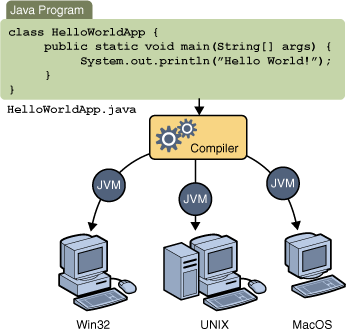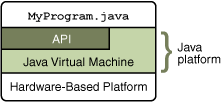Each of the preceding buzzwords is explained in The Java Language Environment , a white paper written by James Gosling and Henry McGilton.
In the Java programming language, all source code is first written in plain text files ending with the
.java extension. Those source files are then compiled into .class files by the javaccompiler. A .class file does not contain code that is native to your processor; it instead contains bytecodes — the machine language of the Java Virtual Machine1 (Java VM). The javalauncher tool then runs your application with an instance of the Java Virtual Machine. An overview of the software development process.
One characteristic of Java is portability, which means that computer programs written in the Java language must run similarly on any supported hardware/operating-system platform. This is achieved by compiling the Java language code, not to machine code but to Java bytecode – instructions similar to machine code but intended to be interpreted by a virtual machine (VM) written specifically for the host hardware. End-users commonly use a Java Runtime Environment (JRE) installed on their own machine for standalone Java applications, or in a Web browser for Java applets. Standardized libraries provide a generic way to access features such as graphics, threading, networking and much more. A major benefit of using bytecode is porting. However, the overhead of interpretation means that interpreted programs almost always run more slowly than programs compiled to native executables would, and Java suffered a reputation for poor performance. This gap has been narrowed by a number of optimization techniques introduced in the more recent JVM implementations.
Because the Java VM is available on many different operating systems, the same
.class files are capable of running on Microsoft Windows, the Solaris TM Operating System (Solaris OS), Linux, or Mac OS. Some virtual machines, such as the Java HotSpot virtual machine, perform additional steps at runtime to give your application a performance boost. This include various tasks such as finding performance bottlenecks and recompiling (to native code) frequently used sections of code. Through the Java VM, the same application is capable of running on multiple platforms.
Java Platform:
A platform is the hardware or software environment in which a program runs. Most platforms can be described as a combination of the operating system and underlying hardware. The Java platform differs from most other platforms in that it’s a software-only platform that runs on top of other hardware-based platforms.

The Java platform has two components:
- The Java Virtual Machine
- The Java Application Programming Interface (API)
Virtual Machine is the base for the Java platform and is ported onto various hardware-based platforms.
The API is a large collection of ready-made software components that provide many useful capabilities. It is grouped into libraries of related classes and interfaces; these libraries are known as packages.
As a platform-independent environment, the Java platform can be a bit slower than native code. However, advances in compiler and virtual machine technologies are bringing performance close to that of native code without threatening portability. A platform is the hardware or software environment in which a program runs. We’ve already mentioned some of the most popular platforms like Microsoft Windows, Linux, Solaris OS, and Mac OS. Most platforms can be described as a combination of the operating system and underlying hardware. The Java platform differs from most other platforms in that it’s a software-only platform that runs on top of other hardware-based platforms.
The general-purpose, high-level Java programming language is a powerful software platform. Every full implementation of the Java platform gives you the following features:
- Development Tools: The development tools provide everything you’ll need for compiling, running, monitoring, debugging, and documenting your applications. As a new developer, the main tools you’ll be using are the
javaccompiler, thejavalauncher, and thejavadocdocumentation tool. - Application Programming Interface (API): The API provides the core functionality of the Java programming language. It offers a wide array of useful classes ready for use in your own applications. It spans everything from basic objects, to networking and security, to XML generation and database access, and more. The core API is very large; to get an overview of what it contains, consult the Java SE Development Kit 6 (JDKTM 6) documentation.
- Deployment Technologies: The JDK software provides standard mechanisms such as the Java Web Start software and Java Plug-In software for deploying your applications to end users.
- User Interface Toolkits: The Swing and Java 2D toolkits make it possible to create sophisticated Graphical User Interfaces (GUIs).
- Integration Libraries: Integration libraries such as the Java IDL API, JDBCTM API, Java Naming and Directory InterfaceTM (“J.N.D.I.”) API, Java RMI, and Java Remote Method Invocation over Internet Inter-ORB Protocol Technology (Java RMI-IIOP Technology) enable database access and manipulation of remote objects.

0 comments:
Post a Comment